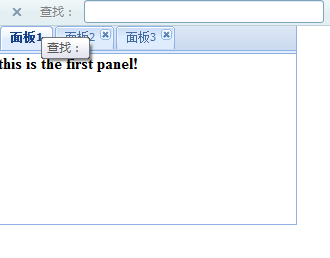选项卡TabPanel控件
选项面板是一个包括一个或多个选项卡(Tab),同一时刻只显示一个选项卡的这种用户界面。比如下图的IE选项设置界面中,就是一个选项板的应用,选项板上有“常规”、“安全”、“隐私”等选项卡。
2、Ext.TabPanel
Ext中提供了选项板控件TabPanel,由类Ext.TabPanel来定义,该类直接继承自Ext.Panel,因此他实际上也是一个包含特定特性的面板。看下面的代码:
<
script type
=
"
text/javascript
"
>
Ext.onReady(
function
(){
new
Ext.TabPanel({
renderTo: Ext.getBody(),
width:
300
,
height:
200
,
enableTabScroll:
true
,
activeTab:
0
,
items: [{
title:
"
面板1
"
,html:
"
<h1>this is the first panel!</h1>
"
}, {
closable :
true
,
title:
"
面板2
"
,
html:
"
<h1>this is the second panel!</h1>
"
}, {
closable :
true
,
title:
"
面板3
"
,
html:
"
<h1>this is the third panel!</h1>
"
}]
});
});
<
/
script>

上面的代码定义了一个简单的选项面板,该面板中包含三个tab,初始化时显示第一个tab内容。
3、另外一种使用选项板的方式
也可以直接把html页面中符合特殊条件的DIV标签转换成选项板中的选项,此时需要在TabPanel的配置选项中把autoTabs项设置为true,把deferredRender项设置为false,然后通过applyTo项指定把页面中包含class="x-tab"这种样式的子节点的DOM节点应用于选项板。看下面的例子:
<
head
>
<
meta http
-
equiv
=
"
description
"
content
=
"
This is my page
"
>
<!--
引入ExtJS样式文件
-->
<
link rel
=
"
stylesheet
"
type
=
"
text/css
"
href
=
"
<%=request.getContextPath() %>/ext-3.2.0/resources/css/ext-all.css
"/
>
<!--
引入ExtJS脚本库(两个,一个驱动adapter,另外一个ext
-
all.js)
-->
<
script type
=
"
text/javascript
"
src
=
"
<%=request.getContextPath() %>/ext-3.2.0/adapter/ext/ext-base.js
"
><
/
script>
<
script type
=
"
text/javascript
"
src
=
"
<%=request.getContextPath() %>/ext-3.2.0/ext-all.js
"
><
/
script>
<
script type
=
"
text/javascript
"
>
Ext.onReady(
function
(){
new
Ext.TabPanel({
applyTo:
'
test
'
,
activeTab:
0
,
deferredRender:
false
,
autoTabs:
true
});
});
<
/
script>
<
/
head>
<
body
>
<
div id
=
"
test
"
>
<
div class
=
"
x-tab
"
title
=
"
选项1
"
>
A simple tab
<
/
div>
<
div class
=
"
x-tab
"
title
=
"
选项2
"
>
Another one
<
/
div>
<
div title
=
"
选项3
"
>
<
div class
=
"
x-tab
"
title
=
"
选项4
"
>
Another one
<
/
div>
<
/
div>
<
/
div>
<
/
body>
由于“选项3”这个DIV标签的class不是x-tab所以不会转换成选项卡Tab,而“选项4”这个DIV虽然与“选项1”这些节点不在同一个层次,但仍然会把他作为Tab项来同等处理。
4、控制选项板的内容
选项板TabPanel中的选项Tab项可以在初始化的时候通过items时候指定,也可以在TabPanel对象创建以后,使用add()、insert()或remove等来动态添加或删除其中的选项卡Tab。为了演示对面板中tab的操作,我们可以给上面的程序简单的添加一个工具栏按钮,当点击按钮的时候在选项面板中动态添加tab。代码如下:
<
script type
=
"
text/javascript
"
>
Ext.onReady(
function
(){
var
i
=
0
;
var
tab
=
new
Ext.TabPanel({
renderTo: Ext.getBody(),
width:
500
,
height:
200
,
enableTabScroll:
true
,
activeTab:
0
,
bbar:[{
text:
"
添加
"
,
handler:
function
(){
tab.add({
title:
"
新面板
"
+
i
++
,
closable :
true
});
}
}],
items:[{
title:
"
面板1
"
,
html:
"
<h1>this is the first panel!</h1>
"
}, {
closable :
true
,
title:
"
面板2
"
,
html:
"
<h1>this is the second panel!</h1>
"
},{
closable :
true
,
title:
"
面板3
"
,
html:
"
<h1>this is the third panel!</h1>
"
}]
});
});
<
/
script>
添加按钮的事件响应函数内容如下:
tab.add({title:"新面板"+i++,closable : true});
我们直接调用选项面板的add方法,就可以把一个面板添加到选项板中,成为一个新的tab。closeable表示该面板可以关闭,因此在tab上会出现一个关闭tab的图标,点击该图标可以关闭该面板。
可以使用迭代功能,实现批量关闭选项板TabPanel中的所有Tab,比如,可以在上面的bbar中,添加一个按钮来实现关闭所有打开的Tab,该按钮的定义代码如下:
{
text:
"
关闭所有面板
"
,
handler:
function
(){
tab.items.each(
function
(p){
if
(p.closable)tab.remove(p);
}
}
}